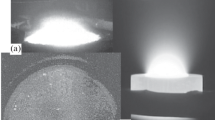Abstract
Experimental results are presented for electrode erosion on copper electrodes in magnetically rotated arcs in argon and helium. Measurements were also made of the arc voltage and velocity. The effects due to the contamination of the electrode surface by either a native contaminant layer (copper oxide and carbon traces) or the continuous injection of very small amounts of various diatomic gases (nitrogen, oxygen, chlorine, and carbon monoxide) into the inert plasma gases were determined. The erosion rates for pure argon were significantly higher than those for pure helium (13.5 μg/C for argon and 1 μg/C for helium) and with both gases, very high arc velocities were measured initially (>60 m/s for argon and >160 m/s for helium) when a natural contaminant layer was still present on the cathode. The removal of this layer resulted in lower velocities (2m/s for argon and 20m/s for helium) and higher erosion rates. The removal of the layer was much faster with argon, due possibly to higher electrode surface current densities for argon arcs.
Similar content being viewed by others
References
A. P. George, “Effect of Cathode Temperature on Erosion Rate in a Schoen-Herr Type Arc Heater Operated on Argon,” 7th International Symposium on Plasma Chemistry, Eindhoven, The Netherlands, July 1–5, Vol. 1, pp. 207–212 (1985).
E. L. Murphy and R. H. Good, “Thermionic Emission, Field Emission, and the Transition Region,”Phys. Rev. 102, 1465–1472 (1956).
G. Ecker, “Electrode Components of the Arc Discharge,”Ergebn. Exakt. Naturw. 33, 1–104 (1955).
F. L. Jones and E. T. Perrelle, “Field Emission of Electrons in Discharges,”Proc. R. Soc. London A,216, 267–279 (1952).
L. W. Swanson, L. C. Crouser,and F. M. Charbonnier, “Energy Exchanges Attending Field Electron Emission,”Phys. Rev. 151, 327–340 (1966).
P. W. Neurath and T. W. Gibbs, “Arc Cathode Emission Mechanism at High Currents and Pressures,”J. Appl. Phys. 34, 277–283 (1963).
A. E. Guile and A. H. Hithcock, “Effect of Transverse Magnetic Field on Erosion Rate of Cathodes of Rotating Arcs,”IEE Proc. 128, 117–122 (1981).
G. A. Farrall, M. Owens, and F. G. Hudda, “A Scanning Electron Microscope Study of Electron Emission and Topography of Surfaces Subjected to Arcing at High Current in Vacuum,”IEEE PES winter meeting New York, C75, pp 102–109, January 1975.
G. A. Farrall, M. Owens, and F. G. Hudda, “Further Studies of Electron Areas on Electropolished Copper Surfaces in Vacuum,”J. Appl. Phys. 46, 610–617 (1975).
C. S. Athwal, K. H. Bayliss, R. Calder, and R. V. Latham, “Field-Induced Electron Emission from Artificially Produced Carbon Sites on Broad Area Copper and Niobium Electrodes,”IEEE Trans. Plasma Sci. PS-13, 226–229 (1985).
P. Niedermann, N. Sankarraman, R. J. Noer, and O. Fischer, “Field Emission from Broad Area Niobium Cathodes: Effects of High Temperature Treatment,”J. Appl. Phys.,59, 892–901 (1986).
D. R. Porto and C. W. Kimblin, “Experimental Observations of Cathode Spot Surface Phenomena in the Transition from a Vacuum Metal Vapor Arc to a Nitrogen Arc,”J. Appl. Phys. 53, 4740–4749 (1982).
R. J. Noer, P. Niedermann, N. Sankarramann, and O. Fischer, “Electron Field Emission from Intentionally Introduced Particles on Extended Niobium Surfaces,”J. Appl. Phys. 59, 3851–3860 (1986).
A. H. Hithcock and A. E. Guile, “Effect of Copper Oxide Thickness on the Number and Size of Arc-Cathode Emitting Sites,”IEE Proc. 124, 148–152 (1977).
A. E. Guile, “Erosion of Non-Refractory Cathodes in Arc Plasma Devices,”Proc. 4th International Symposium on Plasma Chem., Zurich, Vol. 1, pp. 305–310 (1979).
R. N. Szente, R. J. Munz, and M. G. Drouet, “Effect of Low Concentrations of a Diatomic Gas in Argon on Erosion on Copper Cathodes in a Magnetically Rotated Arc,”Plasma Chem. Plasma Process. 7, 349–364 (1987).
R. N. Szente, R. J. Munz, and M. G. Drouet, “Effect of the Arc Velocity on the Cathode Erosion Rate in Argon-Nitrogen Mixtures,”J. Phys. D: Appl. Phys.,20, 754–756 (1987).
L. Cheng znd J. Xie, “Motion of Magnetically Driven Arcs on Oxidized Electrodes,”IEEE Trans. CHMT-5, No. 1, pp. 86–89 (1982).
A. J. Szadkowski, A. Kalnitsky, K. B. Ma, and S. Zukotynski, “Implication of the Change in Work Function of Chromium by the Presence of Hydrogen on the Properties of Electrical Contract between Chromium and Hydrogenated Amorphous Silicon,”J. Appl. Phys. 53, 557–558 (1982).
H. Gerischer, D. B. Kolb, and M. Przasnyski, “Chemisorption of Metal Atoms on Metal Surfaces in Correlation to Work Function Differences,”Surf. Sci. 43, 662–666 (1974).
R. H. Good and E. W. Muller, “Field Emission,”Encyclopedia of Physics, Vol XXI, pp. 176–231 (1957).
V. I. Rakovskii, “Cathode Emission Mechanism in an Arc Discharge,”Sov. Phys. Tech. Phys. 10, 1707–1709 (1966).
F. K. Schulte, “A Theory of Thin Metal Films: Electrondensity, Potentials and Work Function,”Surf. Sci. 55, 427–444 (1976).
Author information
Authors and Affiliations
Rights and permissions
About this article
Cite this article
Szente, R.N., Munz, R.J. & Drouet, M.G. Cathode erosion in inert gases: The importance of electrode contamination. Plasma Chem Plasma Process 9, 121–132 (1989). https://doi.org/10.1007/BF01015830
Received:
Revised:
Issue Date:
DOI: https://doi.org/10.1007/BF01015830




